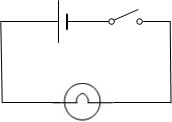Batteries
Claimed by Nathan Batey
A device used in electric circuits to store and distribute voltage.
The Main Idea
A battery is a device that is commonly used in circuits to distribute a voltage through the circuit's path. The battery uses a chemical reaction to produce a potential difference between the positive and negative terminals. The voltage is produced by the work done on charges inside the battery.
Batteries(singular or multiple connected) can technically be referred to as electrochemical cells, and more specifically voltaic cells(because of their nature to produce an external potential difference). When talking about circuits, the potential difference(or voltage) produced by batteries is often referred to as EMF(electromotive force).
The basic principle of a battery can be thought of as 2 plates slightly separated with each plate being oppositely charged. The positive charges want to meetup with the negative charges, and vice versa, but they can't bridge the gap between the plates. In order to reach each other the particles must travel through the circuit via the terminals. In modern batteries, the plates are surrounded by electrolyte fluid and an insulating tube. Because of this a battery creates a potential difference between it's two terminals when connected.
[1]
Types of Batteries
There are different types of batteries, the main difference being the chemical inside producing the reaction.
Alkaline Batteries
Containing potassium hydroxide, an alkaline electrolyte, these batteries are one of the most common
Lithium Ion Batteries
A type of rechargeable battery, with one of the best energy-to-weight ratios
Lead Acid Batteries
One of the oldest batteries, these have a very low energy-to-weight ratios, they can provide short high surges of current and are most commonly found in automobiles
Nickel-Cadmium Batteries
Another type of rechargeable battery, containing nickel oxide hydroxide and cadmium
[3]
Mathematical Concepts
In a circuit, unless connected to another power source, the EMF of the circuit will be equal to the voltage of the battery.
[math]\displaystyle{ {{Voltage}_{Battery}} = {EMF} }[/math]
If multiple batteries are connected in a circuit the EMF of the circuit will be equal to the sum of all the voltages of the batteries. Whether the batteries are connected in series or parallel has no effect on the EMF.
[math]\displaystyle{ {{{Voltage}_{Battery_1}}+{{Voltage}_{Battery_2}}+{...}} = {{EMF}_{Circuit}} }[/math]
Example
a.) If there is a simple circuit, as shown below, with a 9 volt battery and a 3 ohm light bulb , what would the EMF of the circuit be when the switch is left open?
b.) Using the same circuit design as above, what would the total EMF of the circuit be when the circuit is closed?
c.) What will the EMF of the above circuit be if it consisted of three 6 volt batteries instead of the singular 9 volt battery?
Connectedness
I've always been really interested in lighting and sound equipment, and a large percentage of that type of equipment is electronic and uses batteries or circuitry. Having a basic understanding of batteries and how they interact in a circuit is fundamental to any electronic project.
I'm also an electrical engineer so circuits are a large part of my degree's coursework, making batteries fairly important to understand.
As I said above, I'm really interested in lighting and sound, and one day hope to have a career involving that sort of equipment. There is definitely an industry in electronics, because they are now in almost every device we use. In order to make any of those devices mobile, it requires the use of batteries.
History
The battery was invented by Alessandro Volta between the years 1780 and 1800. He first discovered the concepts when he noticed that frog legs would twitch when hung from metal hooks and probed with a metal rod. He continued to experiment and created a crude model using 30 discs a stacked together between wooden sticks. He reported his findings to the world in March of 1800. The invention of the battery was his biggest accomplishment and he continued to experiment with the device throughout the rest of his life.[2]
Answers to the Example
a.)9 volts
b.)0 volts
c.)18 volts
See also
Capacitor, Capacitors, Resistors and Conductivity, Components - Other components of circuits
Resistivity, Current, Current in a RL Circuit, Volt, Voltage - Directly correlated properties of circuits

